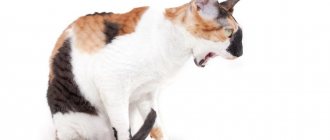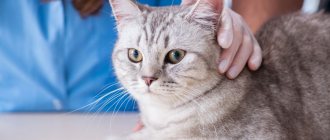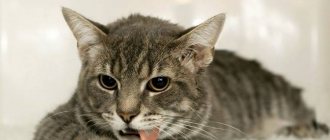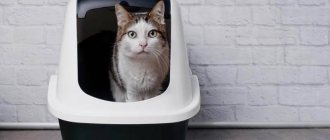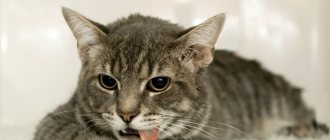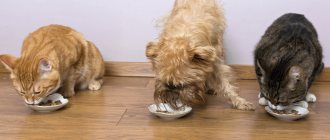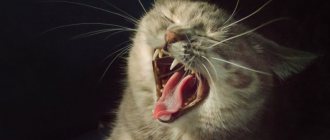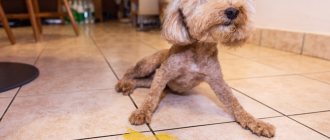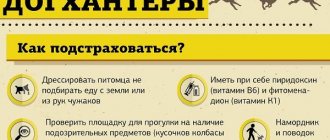What will you learn from the article?
- Causes of Vomiting with undigested food pieces
- Vomiting white foam
- Vomiting bile
- Vomiting blood
- Vomiting with mucus
- Green vomit
- Black vomit
- Vomiting in kittens
- Vomiting in a pregnant cat
- What to give your cat for vomiting
Vomiting in a cat is a reflexive release of the contents of the stomach or intestines through the mouth or nose. Vomiting is a natural protective reaction of an animal to intoxication and poisoning of the body.
In cats, vomiting is preceded by rapid breathing, involuntary swallowing movements (nausea), and copious amounts of saliva. How to help your pet?
Causes
The reasons why a cat vomits are very diverse - from banal overeating or eating too quickly to serious infectious or parasitic diseases.
Most often, vomiting after eating in domestic cats is caused by eating grass or getting hair/fur into the stomach, which causes irritation of the gastric mucosa and a reflex release of its contents.
If a cat vomits once or twice, and there are no changes in the animal’s behavior, then such vomiting is not dangerous, you can help the animal at home.
Keep track of which cat food is best and feed it that way.
If vomiting is frequent, prolonged, and not associated with meals, you need to consult a doctor as soon as possible - such vomiting is a sign of infectious pathologies, kidney or liver diseases.
Therefore, if a cat vomits repeatedly, and even more so if the animal’s behavior changes, then you need to urgently contact a veterinarian.
Video
The appearance of various impurities in the vomit, for example, bile, blood, clots, lumps, should also alert you and requires immediate contact with a veterinarian.
Vomiting with undigested food pieces
The cause of this pathology is ordinary cat greed. The animal is in too much of a hurry, quickly and greedily swallows large pieces, and chews them poorly. This is done by animals that have been starving for a long time or cats living together and competing for food.
The solution to the problem is to ration portions (for example, using automatic feeders) and separate meals for pets living together.
Vomiting white foam
Hunger vomiting always appears as white foam. The digestive system of cats synthesizes all the necessary enzymes and secretions, even if the animal is starving for a long time. The produced gastric juice irritates the empty stomach and esophagus - hence the white foam.
Make sure your pet is always fed!
Vomiting bile
This is a sign of pathology - normally there should be no bile in the stomach. The presence of bile in the vomit indicates diseases of the liver, gall bladder, various infectious and viral diseases: calcivirosis, feline distemper. Severe helminthic infestation manifests itself in this way. A sharp increase in calorie content of food and food poisoning can also provoke bilious vomiting.
Even if your cat vomits yellow bile once or twice, this should not be ignored. Bile aggressively acts on the gastric mucosa and causes inflammation. You can't do without a visit to the veterinarian.
Vomiting blood
There can be two types: with scarlet blood and dark blood the color of coffee grounds. An admixture of scarlet blood indicates injury to the pharynx, damage to the esophagus, and the presence of wounds in the oral cavity. Carefully inspect the animal's oral cavity for wounds and foreign objects.
If the impurity in the vomit is brown, this indicates that bleeding occurs in the stomach, and under the influence of hydrochloric acid the blood changes its color. Gastric bleeding can be caused by foreign objects entering the stomach, gastritis, tumors, or stomach ulcers. You need to immediately contact a specialist.
Vomiting with mucus
Mucus indicates the presence of gastric juice in the vomit. This is how cats feel sick with chronic gastritis, helminthic infestation and some infectious diseases. The cause must be determined by a veterinarian.
Green vomit
This indicates that the contents from the intestines are being thrown back into the stomach or that excessive bile is being produced. This can happen due to problems with the liver, gall bladder, or intestinal obstruction. The latter condition is extremely life-threatening for your pet, so urgent consultation with a veterinarian is necessary.
Black vomit
If the foul-smelling vomit resembles fecal matter in appearance, then the cat has advanced intestinal obstruction or peritonitis. The animal needs urgent medical attention. Intestinal obstruction is a dangerous disease that can be fatal.
Vomiting in kittens
Babies do not have a fully formed gastrointestinal tract; kittens can vomit just like that after outdoor games if they play immediately after feeding.
The second common cause is congenital abnormalities of the gastric sphincter. With this pathology, the digested food is not completely excreted into the intestines, and the kitten regurgitates some of the food. It is necessary to feed such babies often, but in small portions.
Vomiting in a pregnant cat
It usually happens in the morning and has a similar cause as in pregnant women - intoxication of the body. When this happens once or twice in the morning, and the vomit does not contain foreign impurities, there is no particular reason for concern. However, be sure to report instances of such vomiting to your veterinarian.
When the process occurs not in the morning, repeatedly, and the vomit contains foreign impurities, you need to urgently show the cat to a doctor. With severe and repeated vomiting, the animal’s body loses a lot of fluid and dehydration occurs. If a cat is accompanied by diarrhea, then dehydration occurs twice as fast! So be careful.
Symptoms of vomiting
Many owners confuse the symptoms of vomiting with coughing, thinking that their pet vomited due to a severe cough. But it is cough that is a symptom of vomiting, and not vice versa. A normal attack of vomiting has several stages:
- The cat feels nauseous, shows anxiety, moves from place to place, licks itself, makes swallowing movements, and salivates profusely.
- The animal begins to cough, stretches its head forward, and breathes deeply and frequently.
- Contractions occur in the abdomen and throat, vomiting occurs, often at first sterile, and then with contents.
At first the cat feels nauseous, gets restless and licks its lips, and an attentive owner may already notice at this stage that the pet will soon vomit
Treatment. What to do.
First of all, remove food and water - food and liquid only cause additional irritation to the stomach.
If your cat has vomited once and you suspect regular overeating, it is enough to provide a break from food for 5-8 hours.
Water can be given a little at a time, but do not force the animal to drink.
The appearance of appetite is a good sign. But don’t rush to give your cat a full bowl of food. After fasting, food should be given in small portions so as not to harm the gastrointestinal tract. It is better to give often, but just a little at a time.
What to give your cat for vomiting
It is advisable for the first two to three days to follow a gentle diet with rice water, lean boiled chicken or special medicinal feed.
You need to gradually switch from a diet to your cat’s usual diet - remember this. Gradually add your usual food to your diet food until the ratio of your usual food to diet food is maximum.
Folk remedies for vomiting
A decoction of chamomile, which is given 3-4 times a day, 1-4 tablespoons, depending on the size of the cat, has a very good effect on the gastric mucosa. It is most convenient to use chamomile in bags, which you need to brew with boiling water and cool to room temperature. If the cat refuses to drink the broth, give it a drink through a syringe without a needle.
Flax seed decoction is another effective home remedy that is used in the same dosage as chamomile decoction.
We tell you how you can quickly and easily prepare it at home:
- pour 2 teaspoons of flax seeds into a pot or small ladle and pour a glass of boiling water over them;
- cook them for 10 minutes over low heat, stir;
- remove from heat and strain through a strainer;
- cool to room temperature.
Anti-vomiting medications
In case of repeated and severe vomiting in a cat, Cerucal or No-Shpu can be administered intramuscularly at the rate of 0.1 ml per 1 kg of animal weight.
Sorbents are also effective: Enterosgel, Atoxil. The use of electrolyte solutions such as Regidron for severe vomiting will be ineffective.
It is very important to consult a doctor if you experience severe or repeated vomiting, as self-medication can lead to disastrous results. The doctor will help determine the level of dehydration in the body, if necessary, insert an IV and determine the cause of vomiting.
Important!
It is strictly forbidden to self-medicate if you have a too young or, conversely, elderly animal. In this case, you should immediately consult a doctor.
Cerucal
The antiemetic drug Cerucal is produced in Croatia. It normalizes the tone of the digestive tract and works well for vomiting and nausea that occur due to impaired liver and kidney function, and head injuries. It is allowed to prescribe the drug as part of a complex treatment, simultaneously with taking other medications.
Vomiting of a vestibular nature cannot be stopped with Cerucal; for this pathology, it is necessary to prescribe other medications.
The active ingredient is metoclopramide hydrochloride.
Cerucal can be purchased both in tablet form and as an injection solution.
The drug in Ukraine costs from 200 hryvnia for tablets, solution - from 435 hryvnia, and in Russia - tablets from 98 rubles, solution for injection - from 230 rubles.
Atoxyl
IV generation enterosorbent has unique properties. Atoxil powder particles attach simultaneously to several bacterial cells, so the product agglutinates a large bacterial mass at once.
Veterinarians do not recommend giving Atoxil for a long time, as a side effect may occur - constipation in the animal.
The active ingredient is highly dispersed silicon dioxide.
A package of 20 sachets costs from 210 hryvnia in Ukraine. This powder for suspension is not sold in Russia.
Regidron
When a cat vomits, potassium, citrate, and sodium chloride are removed from the body. Regidron contains precisely these substances and glucose. The introduction of this drug into the course of treatment restores the correct balance of electrolytes and maintains the acid-base balance in the blood.
No side effects were noted when using Regidron.
In Ukraine, the drug (20 sachets) costs from 230 UAH, in Russia – from 390 rubles.
When should you contact a veterinarian? How to treat vomiting in a cat?
Vomiting in a pet in itself is a reason to consult a doctor.
Acute vomiting may be accompanied by depression of the general condition, dehydration, and pain, which requires emergency intervention by a veterinarian.
Acute vomiting in a cat can most often be associated with diseases such as:
- pancreatitis
- gastritis
- foreign objects in the digestive tract
- diseases of the hepatobiliary system
- food intolerance, etc.
Prevention
- Monitor the health of your pet; regular examinations by a veterinarian and vaccination of kittens are mandatory.
- Don’t forget to regularly treat your animal with anti-flea and worm preventatives for cats.
- To prevent the formation of hairballs, regularly feed special paste and food.
- Feed your cat high-quality food, following a feeding schedule. Avoid prolonged fasting and overfeeding.
- Monitor your cat's diet. Food and water must be fresh. Divide food into small portions, as frequent overeating can disrupt the normal functioning of the stomach.
- Avoid poisonous indoor plants, store all dangerous and toxic substances and household chemicals in places inaccessible to the animal.
Thyroid problems
Problems with the thyroid gland cause a condition where cats may vomit liquid after drinking water. Hyperthyroidism is a hormonal disease caused by excess secretion of the thyroid gland. This clinical syndrome is difficult to detect. Your cat may also exhibit other symptoms, such as oily skin and fur, acne on the face, or excessive drooling. Thyroid problems can be controlled with special medications and a veterinarian-prescribed diet.
© shutterstock
Owner stories
Matvey: “I inherited a cat from my parents at the age of 10. Some time ago he began to feel sick after eating. I live in a small village, we don’t have a veterinary clinic. A doctor from a neighboring town advised giving the cat Phosphalugel half an hour before meals at a dosage of 0.5 ml per 1 kg of weight. And at night, an hour after the evening feeding, I prescribed the gastroprotector Kvamatel 5 mg per dose. The cat's condition has improved. But we need to take him to a doctor for an accurate diagnosis.”
Louise: “My cats accidentally ate raw fish and didn’t take care of them. After that, both began to vomit, the cats were not used to such food. Vomiting was stopped with a subcutaneous injection of Cerucal (0.1 ml/kg). For dehydration, a saline solution of 10 ml/kg was given. After that, the cats were taken to the clinic.”
This article is presented for informational purposes only and cannot replace a full consultation with a veterinarian. The author of the article is not responsible for your actions.
Video:
Diagnosis of pathologies
The help of a specialist is absolutely necessary if your pet experiences nausea for more than a day or every day.
The veterinarian will diagnose the health condition and also monitor the condition. First of all, he will perform palpation - feeling the abdominal cavity. This will reveal compactions, congestion or tumors. At the same time, the doctor will ask the owner about the cat’s behavior in recent days, about its diet and pastimes.
If a disease is suspected, urine and blood tests will be ordered; in more complex cases, an ultrasound or x-ray will be required. After the results are ready, the veterinarian will tell you what to do if your cat vomits after eating, how and how to treat it. In rare cases (intestinal blockage, tumor), surgery may be required.
Self-diagnosis is only possible if the cat has vomited once and is feeling well. In all other cases, you need to take your pet to the hospital or call a doctor at home.
